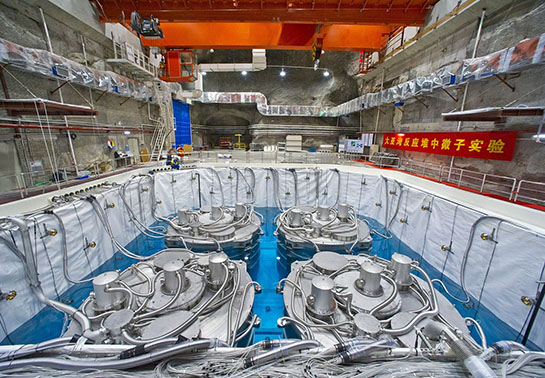A controversy in the study of neutrinos is resolved with a detector developed in the IFIC
- Science Park
- October 2nd, 2019

Researchers at the Instituto de Física Corpuscular (IFIC) have just ruled out the hypothesis about the existence of a new neutrino named “sterile” that created controversy among the scientific community dedicated to study this elementary particle. The project, carried out with a technique developed in the IFIC, is published in Physical Review Letters.
One of the processes that take place during the atomic fission that produces energy in the reactors of nuclear plants is the beta decay. The beta decay generates huge amounts of antineutrinos, which are antimatter replicas of the neutrino, one of the most abundant elementary particles in the universe. Therefore, nuclear plants are used for studying the neutrino and its role in the internal functioning of the matter, crucial for a better understanding of the universe.
A researcher group of the Instituto de Física Corpuscular, joint centre of the Universitat de València and the CISC, at the Science Park of the academic institution, has just published the first comparison between the antineutrinos’ flow detected in Daya Bay’s nuclear power plant (China) and the one obtained in the laboratory form the main fission products with a technique and a detector developed in Valencia.
Until now, the expected flow of antineutrinos from a nuclear reactor was calculated by measures obtained in the 1980s. This model revealed a discrepancy of up to 6% between the expected neutrinos from a nuclear power plant and those actually detected in experiments such as Daya Bay. Some researchers attributed this discrepancy to the existence of a fourth type of neutrino named sterile.
Now, the results obtained by the Valencian research group published in Physical Review Letters reduce this discrepancy by down to 4%, which discards the possibility that this anomaly has its origin in a new class of neutrino yet to be discovered. The study confirms that this discrepancy responds to an error in the calculations used for the estimation of antineutrinos.
This research has been led by the scientists Alejandro Algora (IFIC), José Luis Taín (IFIC) and Muriel Fallot, from Subatech (France). The published work now supposes the culmination of a decade of experiments, performed using the technique known as Total Absorption Gamma-ray Spectroscopy (TAGS), using DTAS detectors, designed in the IFIC.
“This proves that our method, combined by the technique of total absorption gamma-ray spectroscopy, is optimal for calculating the spectrum of antineutrinos produced in the beta disintegrations of nuclear fuel,” Taín emphasises. “This method could improve the calculations of the power obtained in nuclear reactors, in addition to contributing to the design of more effective tools against uncontrolled nuclear proliferation,” he adds.
The impact of these measures on the study of neutrino oscillations in experiments such as Daya Bay, which has studied the phenomenon with greater precision, has yet to be determined. “The study is also relevant for new generation antineutrino oscillation experiments such as JUNO, which is currently being built in China and seeks for a better understanding of the nature of the so-called 'ghost particles”, according to Alejandro Algora.
Reference
“Updated Summation Model: An Improved Agreement with the Daya Bay Antineutrino Fluxes”, M. Estienne, M. Fallot, A. Algora, J. Briz-Monago, V. M. Bui, S. Cormon, W. Gelletly, L. Giot, V. Guadilla, D. Jordan, L. Le Meur, A. Porta, S. Rice, B. Rubio, J. L. Taín, E. Valencia, and A.-A. Zakari-Issoufou. Phys. Rev. Lett. 123, 022502 – Published 9 July 2019
More information:
File in: Física , Ciencias Tecnológicas , Astronomía y Astrofísica
















